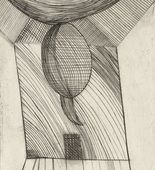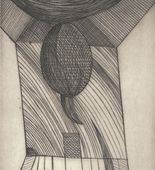
Cat. No. 998.2/VIII, variant 6
Untitled, plate 10 of 11, from the illustrated book, He Disappeared into Complete Silence, second edition
- State/Variant:
- Version 2 of 4, state VIII of VIII, variant
- Date:
- 1995-2003
- Alternate Title:
- Ceiling Floating; Alternative Plate
- Themes
- Abstraction, Architecture
- Techniques
- Engraving, Photogravure
- Support:
- Smooth, wove paper
- Dimensions:
- plate: 7 1/16 × 5 1/16" (18 × 12.8 cm); sheet: 10 × 6 13/16" (25.4 × 17.3 cm)
- Signature:
- Not signed
- Publisher
- unpublished
- Printer
- Harlan & Weaver for engraving, Iris Editions for photogravure (see Curatorial Remarks)
- Edition:
- 9 known impressions of version 2, state VIII, outside the second edition
- Edition Information:
- Proof before the editioning of version 2, state VIII in the second edition.
There are 3 additional impressions of this state in MoMA's Collection (Accession Numbers: 1381.2008, 1384.2008, and 1405.2012). They are not illustrated due to their similarity to the impression seen here. - Impression:
- Not numbered
- Background:
- The first edition of the illustrated book, “He Disappeared into Complete Silence” (cat. no. 1228) was not completed with 54 examples, as announced on the colophon in 1947; it seems few volumes were issued and none included the “Alternative Plate.” At that time, Bourgeois was actively working in printmaking at the Atelier 17 workshop. She decided to create an illustrated book edition with hopes of making her work more widely known. As it turned out, the book was not a success. Later, in the 1980s, Bourgeois began to assemble examples of the book from texts and plates still in her possession. Some of these “assembled” examples (See cat. nos. 1228 [Examples 12, 13, 15, 16]), included a tenth plate, added to the original nine. That tenth plate is the “Alternative Plate,” so-called for cataloguing purposes.
In the 1980s, Bourgeois also began efforts to reissue the book. The printing plates for the original illustrations no longer existed, so she set about producing new ones. She worked first, in 1984, with printer Deli Sacilotto, of Iris Editions, New York, to create photogravures using 1947 impressions of Plates 1, 3, and the “Alternative Plate.” Then, in 1990, she created engraved versions of Plates 2 and 6 with the assistance of Christian Guérin of Gravure, New York. First, though, in order to determine whether Guérin’s engraving was suitable, she asked him to engrave two similar compositions. (See “Atlantic Avenue: Transparent Houses” [cat. nos. 1054.1, .2, .3].)
In 1993, Bourgeois finally turned the project over to printer Felix Harlan of Harlan & Weaver, New York, with whom she had begun to work on a regular basis. Harlan would ultimately serve as both printer and coordinator of the second edition. He started out by making reprints of some of the 1983 photogravures created with Sacilotto, and the 1990 engravings created with Guérin. In addition, since by then Bourgeois had located three of the original printing plates from the 1940s (two versions of Plate 3 and one version of Plate 4), Harlan made reprints from those, but they were too distressed for use in a future edition. He also attempted to remake Plates 5, 8, and 9 in drypoint and/or etching. Finally, Bourgeois decided to work with photogravure as the starting-off point for all the compositions in the book, in order to keep the plates as close as possible to those of the 1947 edition. In 1995, new photogravure plates were made by Renaissance Press from photographs of the first edition in the New York Public Library (cat. no. 1228, Example 12). Working with Harlan, Bourgeois ultimately re-worked these photogravure plates with engraving, also adding aquatint, drypoint, scorper and watercolor additions in some instances.
Bourgeois worked intermittently on this project for over a decade, with the second edition appearing in 2005 as a benefit publication for the Department of Prints and Illustrated Books, The Museum of Modern Art, New York. The book includes the nine original illustrations, along with the “Alternative Plate,” and an eleventh plate titled “Spider.” In addition to the plates, it includes text pages from 1947 that had remained with Bourgeois, as well as a new table of contents, foreword, and colophon. The housing was constructed to match that of the 1947 first edition. - Curatorial Remarks:
- The Renaissance Press made photogravures from photographs of all ten plates in the New York Public Library’s example of “He Disappeared into Complete Silence” (cat. no. 1228, Example 12) to serve as the starting-off point for the second edition (see Background). However, Bourgeois did not use the Renaissance Press tenth plate—the “Alternative Plate.” Instead, she chose to work on a photogravure of this plate made by Deli Sacilotto, of Iris Editions, New York, in 1984. The Contents page of the second edition gives the incorrect dates of (1995-2002) for this “Alternative Plate.” The correct dates should be (1984-2002).
Iris Editions was the imprint of Deli Sacilotto, a master printer who specialized in the photogravure technique. Bourgeois met Sacilotto through mutual friends and established a warm relationship with him. They worked together on projects in the early 1980s, and then again later, when Sacilotto joined Graphicstudio in Tampa, Florida and encouraged the artist to create the multiple, “Spider Home” (cat. no. 15). - Description:
- Engraving over photogravure, with gray watercolor additions
- State Changes and Additions:
- Changes from version 1: composition transferred to new plate in photogravure.
Changes from version 2, state VII, in engraving: curving lines added to end of vertical lines in bottom oval. - Artist’s Remarks:
- "We have entered inside a structure... but there is no window... only a small door. And the occupant is too big to go through the door... it is inflated... it is very emotional. She is trapped; but she is the trapper... she traps herself. She is trapped by her own devices."
Bourgeois related a fable about the "desire to escape." It was a story of a rat. "The rat comes in from under the floor. He finds a beautiful room and a cheese. He gulps and gulps and grows bigger and bigger. Then he can't escape because he can't fit out the hole." She added, "The spot on the floor implies a light source. One can be rational... the spot can lead you to the source of light, and to escape." (Quotes cited in Wye, Deborah and Carol Smith. “The Prints of Louise Bourgeois.” New York: The Museum of Modern Art, 1994, p. 96.) - MoMA Credit Line:
- Gift of the artist
- MoMA Accession Number:
- 1403.2012
© The Easton Foundation/VAGA at ARS, NY
Open to compare works

Select a work in the diagram below
Version 2 of 4, state VIII of VIII, variant
1995-2003
A
B
Untitled alternative plate, from the illustrated book, He Disappeared into Complete Silence
1946-2005
First Version
Second Version
Third Version
Fourth Version
Illustrated Book
2005
Illustrated Book
1947
Related Works in the Catalogue
Related Works in Other Mediums

Not in MoMA's Collection

He Disappeared into Complete Silence
1947
Not in MoMA's Collection

He Disappeared into Complete Silence
1947
Medium: Pencil on paper
Dimensions: sheet: 8 1/2 × 5 1/2" (21.6 × 14 cm)
© The Easton Foundation/VAGA at ARS, NY

Not in MoMA's Collection

He Disappeared Dessin Preparatory
1947
Not in MoMA's Collection

He Disappeared Dessin Preparatory
1947
Medium: Pencil on paper
Dimensions: sheet: 8 1/2 × 3 1/2" (21.6 × 8.9 cm)
© The Easton Foundation/VAGA at ARS, NY

Not in MoMA's Collection

Gemor Press
1947
Not in MoMA's Collection

Gemor Press
1947
Medium: Pencil on paper
Dimensions: sheet: 6 × 3 1/8" (15.2 × 7.9 cm)
© The Easton Foundation/VAGA at ARS, NY

Not in MoMA's Collection

Untitled
1948
Not in MoMA's Collection

Untitled
1948
Medium: Ink on paper
Dimensions: sheet: 11 1/8 × 8 1/2" (28.3 × 21.6 cm)
© The Easton Foundation/VAGA at ARS, NY

Not in MoMA's Collection

Untitled
1948
Not in MoMA's Collection

Untitled
1948
Medium: Ink on paper
Dimensions: sheet: 7 5/8 × 5" (19.4 × 12.7 cm)
© The Easton Foundation/VAGA at ARS, NY




































































